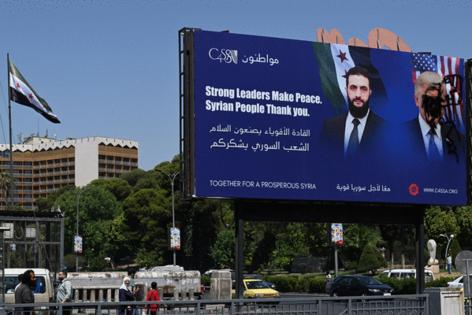Commentary: Trump tries to make history in Syria and Lebanon
Published in Political News
It’s difficult to look at the Middle East today and be optimistic. Every U.S. president since the turn of the century has entered office promising to strike peace agreements in this region, only to leave office without succeeding. The 2020 Abraham Accords, facilitated by President Donald Trump during his first term, was less a peace agreement and more a collection of normalization accords that sought to improve Israel’s diplomatic relations with the few Arab states willing to sign on.
This year doesn’t look especially promising either. Despite the periodic attempts to inject some momentum into diplomacy, the Trump administration has effectively given up on negotiating a comprehensive ceasefire and hostage release deal in Gaza. The nearly 2-year-old war between Israel and Hamas is set to accelerate; tens of thousands of additional Israeli troops have been called up for duty and Israeli warplanes are striking the outskirts of Gaza City in preparation for a full ground offensive in the area. Nuclear diplomacy with Iran is at a standstill as Iranian Supreme Leader Ayatollah Ali Khamenei reiterated over the weekend his opposition to the resumption of direct diplomacy with Washington.
It all seems bleak. But there are two countries in the Middle East where transformative change might be on the horizon: Syria and Lebanon.
Syria might seem like an odd state to list. The nearly 14-year civil war tore the country apart socially, destroyed many of its large cities, killed off whatever economic capacity it possessed and brought several foreign powers, including the United States, into the fray. The Bashar Assad regime’s collapse inspired a wave of optimism about despotism turning into democracy. The new Syrian government, led by former al-Qaida-fighter-turned-politician Ahmad al-Sharaa, inherited a state gutted financially, politically and emotionally. About nine months after assuming power, al-Sharaa’s new regime is struggling to consolidate its authority, in large measure because Syrian minority groups are concerned they will be treated as second-class citizens — or worse— by the Sunni Islamists who now rule Damascus.
Yet it’s not all bad. The emergence of a post-Assad Syria, and al-Sharaa’s willingness to reset the country’s foreign relations, has given Washington an opportunity to take advantage of the new reality. One of the Trump administration’s most significant Middle East initiatives centers on an Israeli-Syrian normalization process. Such a deal would make diplomatic history; Israel and Syria are historic enemies, having fought numerous wars against each other, and a previous attempt to strike a peace agreement between the two by the Bill Clinton administration ultimately frittered away.
Bettors would be smart to put their chips on another failure. It’s highly unlikely Syria will sign a peace or normalization deal with Israel as long as Israeli bombs are killing hundreds of Palestinians in Gaza every week. However, a demilitarization or stability agreement is certainly possible, and it’s one Trump’s envoy for the Levant, Thomas Barrack, has spent months working on. This month, Syrian Foreign Minister Asaad al-Shibani met with Israeli Prime Minister Benjamin Netanyahu’s top policy official in Paris to discuss the security situation in southern Syria. The area is where Israel bombed Syrian troops on their way to Sweida, a Druze-majority city that was engulfed in intercommunal violence at the time. The Israeli military action caused anger not only in Damascus but also in Washington, which has normalized its own relationship with the new Syria.
A deal will depend on whether Israel withdraws to its previous positions in the Golan Heights and al-Sharaa can swallow Israeli demands to turn southern Syria into a no-go military zone, as well as the kinds of concessions the Israelis are willing to make, among other factors.
Lebanon is a trickier case. Unlike Syria, where Israel is dealing with one party, Lebanon is a jigsaw puzzle — everything has to fit for there for progress.
The red lines are clear. Israel wants Hezbollah, the Lebanese militia that took a beating during its war with Israel last fall, disarmed and demobilized. Hezbollah wants to keep whatever arms it has left and demands an end to Israeli airstrikes as well as a full Israeli military withdrawal from the parts of the Israeli-Lebanese border it still occupies. The Lebanese government wants the same Israeli withdrawal and an end to airstrikes, and it wants Hezbollah to hand over its weapons to the state.
U.S. officials are pushing hard. The problem thus far has been sequencing: Who does what first? Israel is emphatic that no withdrawal from Lebanon can take place until the Lebanese government begins the process of disarming Hezbollah. The Lebanese government has argued that by passing a cabinet resolution committing itself to this step, it’s now on the Israelis to give some ground. Hezbollah, meanwhile, is adamant that it can’t hand over its weapons because that would leave Lebanon defenseless against future Israeli aggression. The Trump administration is caught in a catch-22: A Israel-Lebanon peace deal requires all the parties at the table to do their fair share, but nobody is willing to move until they have confidence the other parties will reciprocate.
At the end of the day, the Trump administration is looking at two historic diplomatic accomplishments in Syria and Lebanon, two countries traditionally associated with violence, dysfunction and unaccountability. If Trump happens to pull off even one of these deals, he will earn legitimate praise. But let’s not sugarcoat it: Everything has to go right. And given Trump’s tendency to move on to other things at a moment’s notice, we’ll wait to see if the White House has the attention span to see it through.
____
Daniel DePetris is a fellow at Defense Priorities and a foreign affairs columnist for the Chicago Tribune.
___
©2025 Chicago Tribune. Visit at chicagotribune.com. Distributed by Tribune Content Agency, LLC.
























































Comments